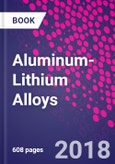Because lithium is the least dense elemental metal, materials scientists and engineers have been working for decades to develop a commercially viable aluminum-lithium (Al-Li) alloy that would be even lighter and stiffer than other aluminum alloys. The first two generations of Al-Li alloys tended to suffer from several problems, including poor ductility and fracture toughness; unreliable properties, fatigue and fracture resistance; and unreliable corrosion resistance.
Now, new third generation Al-Li alloys with significantly reduced lithium content and other improvements are promising a revival for Al-Li applications in modern aircraft and aerospace vehicles. Over the last few years, these newer Al-Li alloys have attracted increasing global interest for widespread applications in the aerospace industry largely because of soaring fuel costs and the development of a new generation of civil and military aircraft. This contributed book, featuring many of the top researchers in the field, is the first up-to-date international reference for Al-Li material research, alloy development, structural design and aerospace systems engineering.
- Provides a complete treatment of the new generation of low-density AL-Li alloys, including microstructure, mechanical behavoir, processing and applications
- Covers the history of earlier generation AL-Li alloys, their basic problems, why they were never widely used, and why the new third generation Al-Li alloys could eventually replace not only traditional aluminum alloys but more expensive composite materials
- Contains two full chapters devoted to applications in the aircraft and aerospace fields, where the lighter, stronger Al-Li alloys mean better performing, more fuel-efficient aircraft
Table of Contents
Part I: Introduction to Al-Li Alloys
Ch 1. Historical Development and Present Status of Al-Li Alloys
Ch 2. Aerostructural Design and its Application to Al-Li Alloys
Part II: Physical Metallurgy
Ch 3. Phase Diagrams and Phase Reactions
Ch 4. Microstructural Evolution in Al-Li Alloys
Ch 5. Texture and Texture Development in Al-Li Alloys
Ch. 6 Strengthening Mechanisms
Part III: Processing Technologies
Ch 7. Melting and Casting
Ch 8. Workability: Rolling, Forging, Extrusion and Forming
Ch 9. Superplasticity in and Superplastic Forming of Al-Li Alloys
Ch 10. Joining Technologies of Al-Li Alloys
Part IV: Mechanical Behavior
Ch 11. Tensile Deformation Behavior and Anisotropy
Ch 12. Fatigue Behavior
Ch 13. Fracture Behavior
Ch 14. Corrosion and SCC Behavior
Part V: Applications
Ch 15. Aerospace Applications of Aluminum-Lithium Alloys
Ch 16. Airworthiness Certification of Metallic Materials








